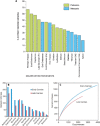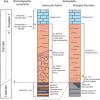Extinction and dawn of the modern world in the Carnian (Late Triassic)
- PMID: 32938682
- PMCID: PMC7494334
- DOI: 10.1126/sciadv.aba0099
Extinction and dawn of the modern world in the Carnian (Late Triassic)
Abstract
The Carnian Pluvial Episode (Late Triassic) was a time of global environmental changes and possibly substantial coeval volcanism. The extent of the biological turnover in marine and terrestrial ecosystems is not well understood. Here, we present a meta-analysis of fossil data that suggests a substantial reduction in generic and species richness and the disappearance of 33% of marine genera. This crisis triggered major radiations. In the sea, the rise of the first scleractinian reefs and rock-forming calcareous nannofossils points to substantial changes in ocean chemistry. On land, there were major diversifications and originations of conifers, insects, dinosaurs, crocodiles, lizards, turtles, and mammals. Although there is uncertainty on the precise age of some of the recorded biological changes, these observations indicate that the Carnian Pluvial Episode was linked to a major extinction event and might have been the trigger of the spectacular radiation of many key groups that dominate modern ecosystems.
Copyright © 2020 The Authors, some rights reserved; exclusive licensee American Association for the Advancement of Science. No claim to original U.S. Government Works. Distributed under a Creative Commons Attribution License 4.0 (CC BY).
Figures





References
-
- Simms M. J., Ruffell A. H., Synchroneity of climatic change and extinctions in the Late Triassic. Geology 17, 265–268 (1989).
-
- Dal Corso J., Gianolla P., Rigo M., Franceschi M., Roghi G., Mietto P., Manfrin S., Raucsik B., Budai T., Jenkyns H. C., Reymond C. E., Caggiati M., Gattolin G., Breda A., Merico A., Preto N., Multiple negative carbon-isotope excursions during the Carnian Pluvial Episode (Late Triassic). Earth Sci. Rev. 185, 732–750 (2018).
-
- Baranyi V., Miller C. S., Ruffell A., Hounslow M. W., Kürschner W. M., A continental record of the carnian pluvial episode (CPE) from the mercia mudstone group (UK): Palynology and climatic implications. J. Geol. Soc. 176, 149–166 (2018).
-
- Dal Corso J., Mietto P., Newton R. J., Pancost R. D., Preto N., Roghi G., Wignall P. B., Discovery of a major negative δ13C spike in the Carnian (Late Triassic) linked to the eruption of Wrangellia flood basalts. Geology 40, 79–82 (2012).
-
- Dal Corso J., Gianolla P., Newton R. J., Franceschi M., Roghi G., Caggiati M., Raucsik B., Budai T., Haas J., Preto N., Carbon isotope records reveal synchronicity between carbon cycle perturbation and the “Carnian Pluvial Event” in the Tethys realm (Late Triassic). Glob. Planet. Change 127, 79–90 (2015).
Publication types
LinkOut - more resources
Full Text Sources

